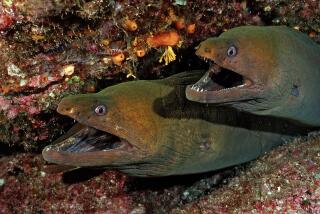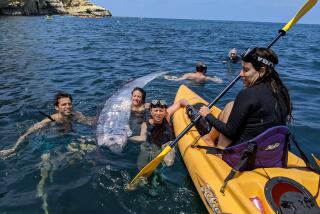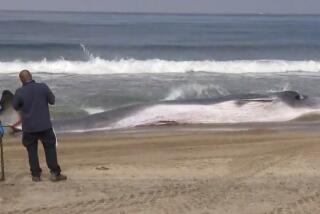Elusive hoodwinker sunfish washes ashore near Santa Barbara in first U.S. sighting

A hoodwinker sunfish washed ashore near Santa Barbara, the first time that the rare creature has been seen in the Northern Hemisphere.
A sunfish that lives south of the equator recently washed up on a Santa Barbara County beach, and scientists are at a loss as to how the giant creature got so off-course.
The massive 7-foot-long and 7-foot-wide fish — a hoodwinker — was discovered Feb. 19 at Sands Beach in Goleta at UC Santa Barbara’s Coal Oil Point Reserve.
Researchers say it’s the first time the fish has been seen in the U.S.
“There are rare finds, and then there are those out-of-nowhere, first-ever discoveries that send scientists’ heart aflutter,” said Shelly Leachman, a spokeswoman for the university.
Local researchers worked with experts across the Pacific to determine the fish was an elusive Mola tecta, a species discovered only two years ago. The fish’s name comes from the Latin word tectus, meaning “hidden,” according to a National Geographic article about the discovery of the species.
The Santa Barbara discovery is remarkable, researchers said, given the fish’s furtive nature and because it was found so far from its normal habitat — the waters of Australia, New Zealand and South Africa.
Snakes, tiny crabs and other creatures: Why the ocean sends us unusual visitors »
Part of the Molidae family, the hoodwinker has a wide body that comes to an end just behind its dorsal and anal fins, giving it an almost flat appearance or that of half a fish. Its “funny-looking pointy fins plopped on it like a bird” make the fish nearly as wide as it is long, said Thomas Turner, who helped confirm the fish is a hoodwinker.
“It’s a big, flat oval-shaped fish … with a constantly surprised look,” said Turner, an associate professor in UC Santa Barbara’s department of ecology, evolution and marine biology. “It’s the weirdest-looking thing you’ve ever seen.”
The fish was first spotted in shallow water by Jessica Nielsen, a conservation specialist at the university’s Coal Oil Point Reserve who was doing research on the beach. Later, an intern found the fish dead on the shore.
The reserve posted photographs of the animal on Facebook, and because it appeared to be a Mola mola — an ocean sunfish common in the Santa Barbara Channel — researchers left the giant fish on the beach, to be recycled naturally.
The Mola mola species is an open-water fish that swims in the depths of the Pacific Ocean. It floats up to the water’s surface to bask in the sun — hence its “sunfish” name. Despite its flat shape, the Molidae are not like flounder, which wiggle along the ocean floor. Instead, the Mola mola — the heaviest fish in the ocean, with some weighing more than 5,000 pounds — swims slowly in the deep ocean.
The Mola tecta is genetically different from the Mola mola, but the physical differences are subtle. The hoodwinker is more slender and has a flap instead of a tail with bony structures along the end of it. The scales are also more like sandpaper, unlike the smooth scales of the Mola mola.
The Mola mola has been found south of the equator, but it’s more rare there than in its common swimming grounds in the Santa Barbara Channel.
Turner saw the fish’s photo on the reserve’s Facebook post and wanted to see the odd-looking animal for himself. So after work, he drove his wife and 4-year-old son, Wren, to the beach to check out the sea creature.
The boy was impressed with the animal’s scales, which have small pointy spikes all over them, and its toothless, beak-like mouth.
Turner then posted photographs on iNaturalist, a social media site for amateurs and professionals interested in learning about different animal species, which caught the eye of Marianne Nyegaard, a researcher in Australia’s Murdoch University.
She saw the species for the first time in 2015 in New Zealand and called it the hoodwinker because of its tendency to blend in with other sunfish species and hide in plain sight.
The fish had previously been spotted more than 100 years ago — in Holland in 1889, far from its normal warm climes. But it was mis-identified as a Mola mola until Nyegaard officially described it in 2017 in an academic journal. It was the first species added to the Mola genus in 125 years.
When a fellow scientist alerted Nyegaard that the California researchers might have a hoodwinker on their hands, she said she couldn’t believe it.
“I was super skeptical,” she said. “I thought, ‘It would be so cool if it was one.’ ”
Nyegaard suspected the Santa Barbara fish was the new Mola tecta species but was reluctant to make a final determination because the animal was found so far away from its natural habitat.
She advised Turner and the other researchers to examine the fish further and gave them specific instructions on what photographs she would need in order to determine its species.
Nyegaard said she cautioned herself not to get too excited, but when the additional images were sent, she said there was no doubt about the type of fish.
“I yelled out, ‘It’s a hoodwinker!’ I just fell off my chair.”
Turner said so little is known about the Mola tecta that researchers don’t really know how rare it is. Either the sunfish is actually common in more northern Pacific waters and simply hasn’t been seen until now, or the hoodwinker made a long trek to the West Coast, he said.
Regardless, it’s odd the fish ended up stranded on the beach, scientists said, adding that Nyegaard’s research will help determine what went wrong.
Researchers said the fish had no signs of injury and wasn’t obviously in distress. It’s possible, Turner said, that ocean warming caused the animal to veer off-course.
Watch as tiny red crabs cover the beaches of Orange County »
The ocean has been unusually warm for years now, causing species to move farther north from their normal habitats, said Elliott Hazen, an ecologist with the National Oceanic and Atmospheric Administration who specializes in water temperature’s impact on wildlife.
Just this week, a dead humpback whale ended up in Brazil at the mouth of the Amazon River. Researchers suspected the mammal was lost at sea and died of an unknown cause.
And this isn’t the first time out-of-place sea creatures have washed up on Southern California beaches. In January 2018, a rare venomous sea snake more common to the coasts of Africa, Asia and Central America, was discovered on the shore in Newport Beach. And a giant oarfish, normally found at ocean depths around 3,000 feet, washed ashore on Catalina Island in August 2015.
Hazen suspects these rare occurrences have to do with fluctuations in ocean temperatures. Changes in weather patterns — such as an El Niño or La Niña event — can either warm or cool the waters around the equator, allowing species to cross that normal barrier.
Extreme changes in water temperatures can also lead to sickness in sea creatures.
“The equator acts as a barrier to migration for fish species,” Hazen said. “[Species] like marlin, they will swim right up to the equator and just kind of bounce back. But when there’s warming or changes in ocean currents that are not normally seen, you can get these species that cross that barrier when they normally wouldn’t.
“Large species, such as the humpback whale found in the Amazon, have very good navigational skills,” he said. “But when they get sick, they can lose that sense of direction.”
Twitter: @r_valejandra
More to Read
Sign up for Essential California
The most important California stories and recommendations in your inbox every morning.
You may occasionally receive promotional content from the Los Angeles Times.











